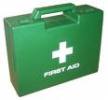
Heat Season Starts Now
Outdoor workers should be protected against excessive heat exposure, and particularly if they are wearing protective apparel.
- By Jerry Laws
- May 01, 2010
The perils that may be encountered when working outdoors are well known. Heat is a primary concern during the summer months in the United States, with stepped-up road construction in some regions and UV radiation a significant concern. Recently enacted heat stress prevention laws may come into play:
 The Washington State Department of Labor & Industries enacted a rule to protect outdoor workers from excessive heat exposure and put the rule into effect on July 5, 2008. The rule requires all employers who have employees working outdoors to supply drinking water, provide training, and monitor for signs of heat-related illness from May 1 through Sept. 30 if workers are exposed to outdoor heat at 52 degrees F or higher when wearing chemical-resistant suits or vapor barrier clothing or PPE, at 77 degrees or higher when they are wearing double-layered clothes including coveralls, jackets, and sweatshirts; and at 89 degrees or higher when they are wearing any other type of clothing.
The Washington State Department of Labor & Industries enacted a rule to protect outdoor workers from excessive heat exposure and put the rule into effect on July 5, 2008. The rule requires all employers who have employees working outdoors to supply drinking water, provide training, and monitor for signs of heat-related illness from May 1 through Sept. 30 if workers are exposed to outdoor heat at 52 degrees F or higher when wearing chemical-resistant suits or vapor barrier clothing or PPE, at 77 degrees or higher when they are wearing double-layered clothes including coveralls, jackets, and sweatshirts; and at 89 degrees or higher when they are wearing any other type of clothing.
Shutdowns in California
Cal/OSHA shut down 16 work sites in 2009 for imminent heat hazards, and the agency issued nearly $2 million in fines and 1,158 citations for alleged violations of its Heat Illness Prevention Standard, which requires adequate drinking water and shade to be provided. The agency warns employers that they can be cited for serious violations if the outdoor temperature exceeds 85 degrees F and no shade is available and they could be shut down if the temperature is above 90 degrees and no shads is available. The amount of shade available should be sufficient to cover at least 25 percent of the workers who are present, according to the agency.
Cal/OSHA began its summer 2010 heat illness training schedule on April 19 in Stockton and continues the series through June 23 in Santa Ana. Sensibly, almost all of the training sessions have a scheduled start of 9 a.m.
Additional Summer Hazards
NIOSH offers heat stress prevention advice here. As for outdoor hazards in general, NIOSH notes they include noise, lightning, venomous wildlife and insects, and poisonous plants, in addition to extreme heat. Farmers, foresters, landscapers, groundskeepers, emergency responders, airport ground crews, gardeners, painters, roofers, construction workers, laborers, mechanics, and any other workers who spends most of them working time outside.
Employers should train outdoor workers about these hazards, conduct a hazard analysis, identify and provide protective equipment, and install practices such as job rotation and rescheduling the most labor-intensive tasks for cooler hours, when possible, to lessen exposures, authorities stress.
About the Author
Jerry Laws is Editor of Occupational Health & Safety magazine, which is owned by 1105 Media Inc.